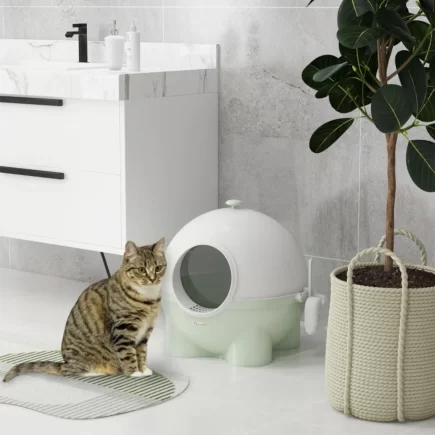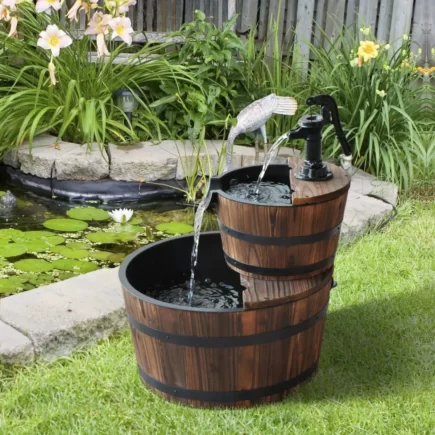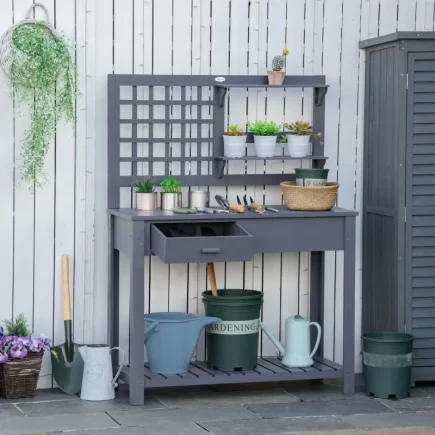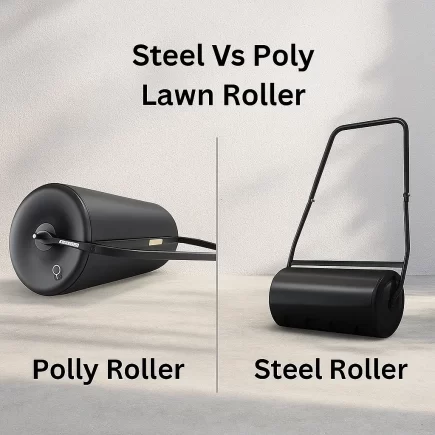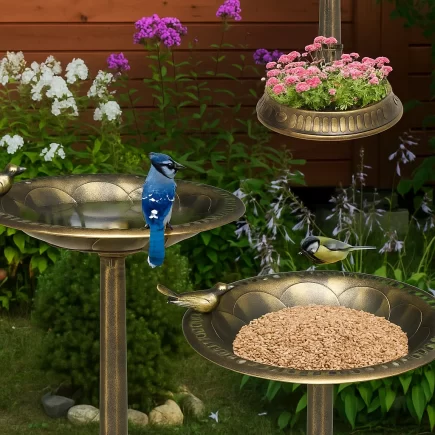Garden fountains are beautiful, peaceful, and inviting additions to any outdoor space. They provide a tranquil ambiance, enhance the beauty of your garden, and give off a soothing, relaxing sound of flowing water. However, like any outdoor feature, garden fountains require regular maintenance to keep them looking their best and working efficiently. Without proper care, fountains can quickly become clogged, dirty, or even damaged.

In this comprehensive guide, we’ll go over how to clean and maintain your garden fountain step by step, providing tips and techniques to ensure it stays pristine and functional for years to come.
Materials Required for Cleaning a Garden Fountain
To ensure a smooth and effective cleaning process, gather all the necessary tools and materials before getting started. The right supplies will help you clean thoroughly and avoid damaging your fountain or pump.
General Cleaning Supplies

| Item | Purpose |
| Mild dish soap | For cleaning the fountain basin and decorative parts |
| Warm water | To mix with dish soap for a gentle cleaning solution |
| White vinegar | Used to treat mineral deposits and tough stains |
| Bucket or large container | For mixing cleaning solutions |
| Soft brush or sponge | To scrub basin surfaces without scratching |
| Toothbrush or small brush | For cleaning pump parts and tight spots |
| Garden hose | For rinsing the fountain and flushing the pump |
| Clean cloth or towel | To dry components after cleaning |
Tools for Water Removal and Pump Maintenance
| Item | Purpose |
| Siphon or scoop | For draining fountains without a drain plug |
| Rubber gloves | To protect your hands during cleaning |
| Water-resistant sealant (optional) | For repairing small cracks in the basin |
| Waterproof cover or tarp | To protect the fountain in winter or when not in use |
| Screwdriver (if needed) | To disassemble certain pump parts |
| Vinegar and distilled water (50/50) | For soaking pump parts and dissolving buildup |
Preparation for Fountain Cleaning
Before diving into the actual cleaning process, it’s important to properly prepare your fountain for the task ahead.
- Turn Off the Fountain and Unplug the Pump
The first thing you should do before cleaning your fountain is to turn off the power supply and unplug the pump. This is a necessary safety step to avoid electrical hazards while you’re cleaning the water feature. You’ll also want to ensure the pump is completely turned off to avoid damaging it during the cleaning process.
- Drain the Water
Next, you’ll need to drain all the water from the fountain. If your fountain has a drain plug, this is the easiest way to empty the basin. Simply remove the plug, and the water will begin to drain out. If your fountain does not have a drain plug, you can use a siphon to remove the water or scoop it out manually using a container.
- Remove Decorative Items, Plants, and Debris
Once the water is drained, carefully remove any decorative items, statues, stones, or plants from the fountain. This is to prevent damage to any fragile elements during the cleaning process.
Additionally, you’ll want to remove any leaves, twigs, or other debris that have accumulated inside the basin. This will make it easier to clean the fountain’s surfaces and prevent clogging the pump later on.
Step 1: Cleaning the Fountain Basin
Now that your fountain is fully drained and cleared of any debris, it’s time to tackle the fountain basin, the area where water sits and where dirt, mineral buildup, and algae tend to accumulate.
Using a Mild Dish Soap and Warm Water Solution
For most types of fountains, a mild dish soap solution is sufficient for cleaning the basin. Here’s how to proceed:
- Mix Soap and Water
In a bucket or large container, mix a few drops of mild dish soap with warm water. Make sure the solution isn’t too soapy, as a heavy amount of soap can leave a residue on the fountain surfaces.
- Scrub the Basin

Use a soft brush or sponge to gently scrub the interior surfaces of the basin. Focus on areas that have visible dirt, grime, or algae. Scrub the sides and bottom of the fountain thoroughly, but be gentle to avoid scratching the surface.
- Clean the Decorative Pieces
If your fountain has rocks, statues, or other decorative elements, scrub these pieces with the soapy solution as well. Be sure to clean all the nooks and crannies of these items to remove any dirt buildup.
- Rinse the Basin
After you’ve finished scrubbing, rinse the basin thoroughly with clean water. This will remove any soap residue and ensure the fountain is completely clean before refilling it with fresh water.
Treating Tough Stains with a Vinegar-Water Solution
If your fountain has stubborn stains, such as mineral deposits or algae, you can use a more powerful solution made from vinegar and water. Vinegar is a natural cleaner that effectively removes mineral buildup and algae without damaging the fountain.
- Mix the Vinegar Solution
In a separate container, mix one part white vinegar with nine parts water.
- Apply the Solution
Pour the vinegar-water solution onto any stained areas, making sure to cover the affected spots thoroughly.

- Let it Sit
Allow the solution to sit for 10–15 minutes. This will give the vinegar time to break down the mineral deposits or algae.
- Scrub with a Soft Brush
After letting the solution sit, use a soft-bristled brush to scrub the stains. Focus on crevices and hard-to-reach spots where buildup is often concentrated.
- Rinse Thoroughly
Once the stains are gone, rinse the fountain thoroughly with clean water to remove any vinegar residue.
Step 2: Cleaning the Fountain Pump
The pump is an integral part of your fountain, responsible for circulating the water and maintaining proper water flow. If the pump becomes clogged with debris, mineral deposits, or algae, it can affect the overall function of your fountain. Cleaning the pump regularly is essential to keep your fountain running smoothly.
Backflushing the Pump
Backflushing is a simple technique that allows you to clean the pump without disassembling it. Here’s how to backflush your fountain pump:
- Remove the Pump

First, remove the pump from the fountain. If the pump is difficult to remove, consult the manufacturer’s instructions for guidance.
- Set Up the Backflush
Attach a garden hose to the intake or outflow tube of the pump.
- Run Water in Reverse
Turn on the water supply and run water through the pump in reverse. This will flush out any debris, algae, or mineral buildup that may be clogging the pump.
- Inspect the Pump
After backflushing, check the pump for any remaining buildup. If necessary, use a small brush or toothbrush to clean hard-to-reach areas.
Detailed Pump Cleaning Techniques
If backflushing doesn’t completely clean the pump, you may need to disassemble it and clean the individual parts. Here’s how:
- Remove the Pump Parts
Take apart any removable components, such as the impeller, cover, or filter.
- Soak the Parts
Soak the individual parts in a solution of distilled water and vinegar (50/50) for 10–15 minutes. The vinegar will help dissolve mineral deposits and other buildup.
- Scrub with a Soft Brush
Use a small brush to scrub the parts and remove any remaining dirt or algae.
- Rinse Thoroughly
Once the parts are clean, rinse them thoroughly with fresh water to remove any vinegar solution.
- Reassemble the Pump
After the parts are dry, reassemble the pump and place it back into the fountain.
Step 3: Rinsing and Refilling the Fountain
After thoroughly cleaning the fountain basin and pump, it’s time to rinse everything thoroughly and refill the fountain with fresh water.
Rinsing the Fountain
Use a garden hose to rinse the entire fountain, including the basin, pump, and any decorative elements. Make sure to flush out any remaining soap, vinegar, or dirt that may be left behind. Thorough rinsing will help ensure that the water stays clean and free from any harmful chemicals.

Refilling with Fresh Water
Once everything is rinsed clean, it’s time to refill the fountain. While tap water is an option, distilled water is the best choice for fountains. Distilled water is free from minerals that can cause buildup and staining in the fountain.
- Why Use Distilled Water?
Distilled water has been purified through a process that removes minerals and contaminants, reducing the risk of mineral deposits, which are common in hard water. Using distilled water will help keep your fountain cleaner and prolong the life of the pump.
Water Quality Management
Maintaining clean, clear water in your fountain is essential for both its appearance and functionality. Poor water quality can lead to algae growth, murky water, and unpleasant odors. Here’s how to maintain water quality in your garden fountain:
Preventing Algae Growth with Aquatic Plants

One of the most effective ways to prevent algae growth in your fountain is by adding aquatic plants. These plants naturally absorb nutrients that algae need to grow, and they help shade the water, limiting the amount of sunlight that algae require.
| Aquatic Plant | Benefits |
| Water Lilies | Shade the water, preventing algae growth |
| Lotus | Reduces nutrients in water, preventing algae |
| Water Hyacinth | Absorbs excess nutrients, prevents algae |
Using Algaecides
In addition to aquatic plants, consider using an algaecide to keep the water clear. Algaecides are chemicals or natural products that kill or inhibit the growth of algae, ensuring your fountain remains clean and clear.
Maintaining Proper Water Levels
Maintaining the correct water level in your fountain is crucial for the efficient operation of the pump. If the water level gets too low, the pump can become damaged due to overheating. On the other hand, overfilling the fountain can cause water to overflow, potentially damaging the surrounding landscaping.
To keep water levels in check:
- Check the Water Level Regularly
Monitor the water level in your fountain frequently. On hot days, the water can evaporate quickly, so you may need to top it up.
- Avoid Overfilling
Do not overfill the fountain, as water that splashes over the edge can damage the surrounding garden or patio.
- Refill with Fresh Water
Always top off the water with fresh water. If you use tap water, consider using a water conditioner to reduce the risk of mineral buildup.
Eco-Friendly Cleaning Solutions
For those who prefer eco-friendly methods, there are many natural and non-toxic ways to clean and maintain your fountain. Eco-friendly cleaning solutions are not only safe for the environment but also for pets and wildlife that may drink from the fountain.
Here are some natural alternatives for cleaning and preventing algae growth:
Barley Straw for Algae Control
Barley straw is a natural method of controlling algae in fountains. When placed in the water, barley straw releases enzymes that prevent algae growth by depriving the algae of essential nutrients.
- How to Use: Simply place a bundle of barley straw in the fountain or attach it to the pump. As the barley straw decomposes, it will release its natural enzymes into the water.
Copper Coins

Copper is toxic to algae and can help keep your fountain’s water clear. Adding a few copper coins to the fountain can significantly reduce algae growth.
- How to Use: Drop 2–3 copper coins into your fountain’s water. The copper ions will slowly leach into the water, inhibiting algae growth.
Enzyme Cleaners
Enzyme cleaners are non-toxic and biodegradable cleaners that break down organic matter in the water. These cleaners help prevent algae buildup and reduce the need for harsh chemical cleaning agents.
- How to Use: Follow the manufacturer’s instructions to add enzyme cleaners to the fountain. They usually come in liquid form and can be poured directly into the water.
Seasonal Fountain Maintenance
Proper seasonal care is essential to protect your fountain from the harsh effects of temperature changes. Whether it’s winterizing your fountain in the cold months or preparing it for the summer heat, seasonal maintenance will help extend the life of your fountain.
Winterizing Your Fountain
Cold temperatures can be harsh on your fountain, especially if you live in a region where temperatures drop below freezing. If water freezes inside the fountain, it can cause cracks in the basin or damage the pump. To winterize your fountain:
- Drain the Fountain Completely
Empty all water from the fountain to prevent freezing.
- Remove and Store the Pump
Disconnect the pump and store it in a warm location. If your fountain is too large to remove the pump, you can cover it with a waterproof cover to protect it from freezing.
- Cover the Fountain
Cover the fountain with a weatherproof tarp or cover to protect it from snow and ice.

- Protecting the Fountain from Cracking
If you have a concrete or stone fountain, apply a sealant to the surface to prevent moisture from seeping in and freezing.
Preserving the Aesthetic of Your Fountain
Your fountain is a beautiful piece of outdoor decor, and preserving its aesthetic appeal is an important part of maintenance. Here are some tips to keep your fountain looking its best:
Avoiding Stains and Discoloration
Mineral deposits from hard water and algae buildup can cause staining and discoloration on your fountain. Regular cleaning, especially using distilled water, will help minimize these stains. If stains occur, use vinegar or a mild acidic cleaner to treat the stains as soon as they appear.
Regular Inspections for Cracks and Wear
Fountains made of materials like concrete or stone are susceptible to cracks due to the constant exposure to water and fluctuating temperatures. Regularly inspect the fountain for any cracks or signs of damage. If you notice any small cracks, you can apply a sealant or use waterproof filler to repair them before they become larger issues.
Preventing Surface Damage
To prevent surface damage from dirt, debris, or harsh weather, make sure to clean the fountain regularly and cover it during harsh weather conditions like snow or heavy rain. A protective cover can prevent dust, leaves, and other debris from accumulating in the fountain when not in use.
Keeping Your Fountain Beautiful Year-Round
Cleaning and maintaining your garden fountain is essential for its aesthetic appeal, functionality, and longevity. By following the steps outlined in this guide, you can ensure that your fountain remains a beautiful and tranquil feature in your outdoor space for many years to come. Regular maintenance, including cleaning the basin and pump, checking water quality, and performing seasonal care, will help prevent common issues like algae buildup and clogged pumps. Additionally, using eco-friendly cleaning solutions and maintaining proper water levels will contribute to a healthy and environmentally safe water feature.
If you’re looking for high-quality garden fountains, be sure to check out Aosom’s collection of Garden Fountains. With a wide variety of styles and designs, you’re sure to find the perfect fountain for your garden or outdoor space!
FAQS
1.My fountain water is turning green. What should I do?
Green water in your fountain is typically caused by algae growth. To resolve this, clean the basin with vinegar and water, scrub the pump, and consider using an algaecide or adding aquatic plants to naturally prevent algae.
2.How can I prevent my fountain pump from clogging?
To avoid pump clogs, regularly remove debris like leaves or twigs from the water. Clean the pump and filter monthly and backflush it to ensure smooth water flow and prevent buildup.
3.How often should I clean my fountain?
It’s ideal to clean your fountain once a month, but if it’s located in a heavily vegetated area or exposed to lots of debris, you may need to clean it more often to prevent clogging and algae buildup.
4.How do I remove hard water stains from my fountain?
Hard water stains can be removed by applying a vinegar-water solution to the stained areas, letting it sit for a few minutes, and then scrubbing with a soft brush. For tougher stains, you may need to use a specialized cleaner.

